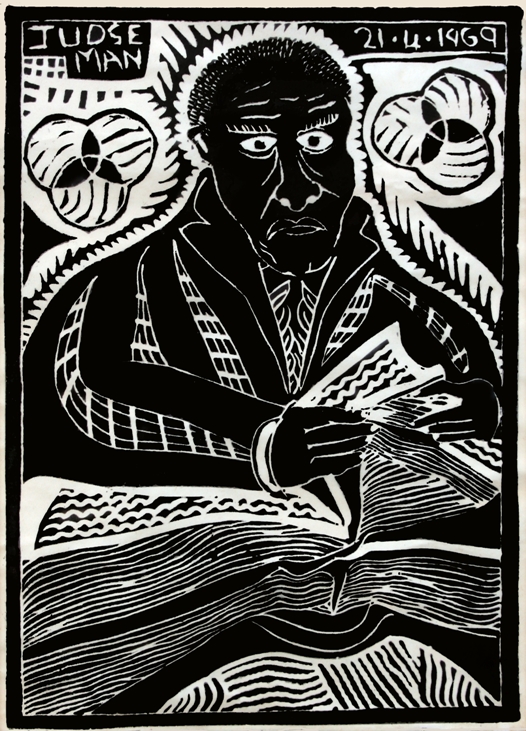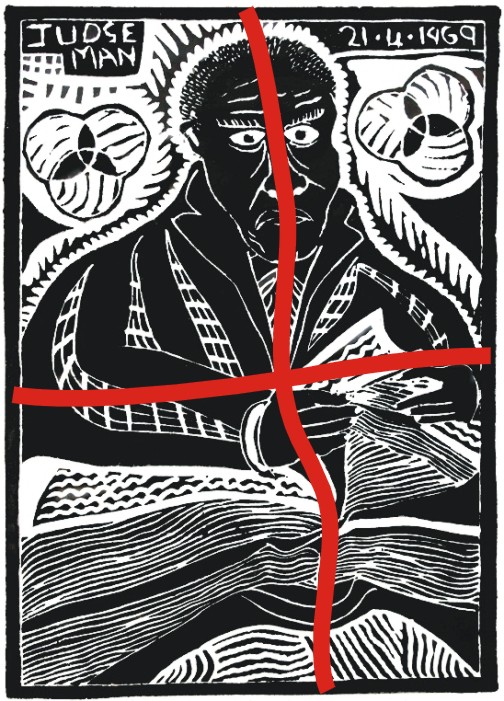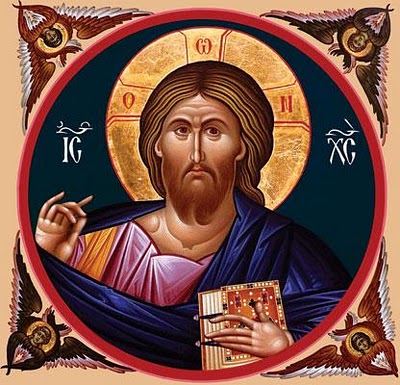Art and the Church

What Kind of God? Judge Man by John Muafangejo
Word and Image Bible Study – What kind of God? Judge Man by John Ndevasia Muafangejo
Target group For small groups or personal study
John Ndevasia Muafangejo was born in 1943 in Etunda lo Nghadi in the area Ovamboland in Namibia, was sent to a missionary school, then studied from 1967-69 at the Art Centre in Rorke's Drift Mission Station in South Africa. He was a man of deep Christian faith and frequently illustrated themes from the Bible. He often intended to express his concerns about injustice and suffering through his work. In 1988 at the height of his career shortly after opening an exhibition of his works his works at Royal Festival Centre in London, he died suddenly of a heart attack. He remains to this day Namibia’s most renowned artist.
Judge Man, 1969, is a lino-cut. The image is 28x20cm, and is printed in black ink on newsprint. In this print Muafangejo portrays the subject in a powerful, enigmatic and compelling way. We wonder who this judge is and are led to consider the nature of justice as well as to examine our own nature, so prone to judging others.
Aim The aim of this study is to look into our own hearts and to think about the image of God that we, through our actions, words and attitudes, reflect to those with whom we come into contact. Are we responsible for turning people away from faith because we secretly believe in a stern God of vengeance, ready to visit judgement upon us at the slightest misdemeanour? Do we really believe that Jesus died, once and for all, for all of our and others' sins? We will study the texts from the Bible that will show us how God wants us to be, with our mind renewed by his Spirit. Perhaps Muafangejo's frightening image will engrave itself upon our memory and help us remember how not to be.
Structure of the study First consider Muafangejo's lino-cut. Carefully take note of all the elements that make up this picture. What could they mean? What could the artist be trying to communicate about the person he's portraying? Is this a real person the artist has seen or is it a person the artist has created from his imagination? Think about who the artist was and about his background: a black man living in a country where the laws controlling his life were not just, even though the ruling government purported to be Christian.
Please allow the discussion to flow freely. Interpretation is part of the creative process and each person's insights are valid. The comments printed in blue may be read once the group has said its say or may be used to get the discussion going should it falter.
Next read the passages listed and consider what they contribute to the discussion.
It may be helpful to have a Concordance on hand, should anyone wish to look up a Bible passage that comes to mind during the discussion of the image.
Let's look at Judge Man by John Ndevasia Muafangejo If possible, project the lino-cut unto a large screen or your computer or television screen. Or print out a copy of it for each person.
What do you see?
How do you feel?
How do you feel?
Take a few minutes to look at it in silence before discussing it.
The large head and bulky shoulders of a man occupy most of the upper half of the picture plane, which is intersected horizontally by an arm and two hands holding the pages of a book that occupies most of the lower half of the picture. A frame around the picture plane serves to hold the figure firmly in place, right up against the viewer, making this man seem confrontational. There is no space around, behind or in front of the figure. Two strange symbols, made up of three intersecting circles, fill the area on either side of the man's head. The artist has used fine lines to draw the man's features, but his outline is made by thicker lines radiating outward, like the sun's corona. The composition is almost symmetrical, although the lines of balance are somewhat wavy, making the picture very dynamic, alive and full of movement.
 |
 |
Compare Muafangejo's picture to traditional iconic images of Christ Pantocrator (Ruler and Judge of the World). What are the similarities and what are the differences? Is it possible that the artist has created a 20th-century version of Christ the Judge or is he portraying mere human justice?
Muafangejo has created a figure radiating authority - a Judge - looking stern and very unfriendly. He searches through the pages of a huge book. You can almost hear the pages crackling. Whatever he's looking for does not seem as if it could possibly be a precedent for mercy. Not with those angry eyes, that ominous frown! Is this what it's going to feel like for those whose names are not in the Lamb's book of life when Judgement Day comes?
Let's turn to the Bible
Psalm 75:7-8
Does this passage make you feel uncomfortable? Or do you feel a sense of satisfaction at the thought that 'They'll sure get what's coming to them!' Did anyone in particular spring to mind when you read that 'all the wicked on earth' will taste God's wrath?
Does this passage make you feel uncomfortable? Or do you feel a sense of satisfaction at the thought that 'They'll sure get what's coming to them!' Did anyone in particular spring to mind when you read that 'all the wicked on earth' will taste God's wrath?
Luke 13:2-5
When you hear that something bad has happened to someone, do you - even for a moment - wonder what they did to deserve it? Do you ever associate the idea of punishment with things that befall you?
When you hear that something bad has happened to someone, do you - even for a moment - wonder what they did to deserve it? Do you ever associate the idea of punishment with things that befall you?
Matthew 7:1-5
We sometimes disguise our judgemental attitudes as concern for others. We look at them sternly and critically and say: ‘I'm only trying to help. I'm a real friend, because I tell you your faults.’ What plank-in-the eye is preventing us from being truly helpful? What do others really need from us? How should we look at them? How does a loving mother's gaze, for instance, differ from Judge Man's stare?
We sometimes disguise our judgemental attitudes as concern for others. We look at them sternly and critically and say: ‘I'm only trying to help. I'm a real friend, because I tell you your faults.’ What plank-in-the eye is preventing us from being truly helpful? What do others really need from us? How should we look at them? How does a loving mother's gaze, for instance, differ from Judge Man's stare?
Romans 14:1-4 and v.10 and v.13
It has been said that the 'Army of Christ' is the only army in the world that stomps on its own casualties. Why do you think it is that so many Christians are wounded in the Church, by fellow Christians?
It has been said that the 'Army of Christ' is the only army in the world that stomps on its own casualties. Why do you think it is that so many Christians are wounded in the Church, by fellow Christians?
Matthew 28:18-20 and 1 Corinthians 4:5
What do these passages tell us about justice? What is our part of the job, as Christians?
What do these passages tell us about justice? What is our part of the job, as Christians?
Isaiah 42:1-4
This prophetic passage is about Jesus, the Servant of the Lord. What does it have to say about his manner of meting out justice? What does it say about how we should portray him to others through our attitudes, words and deeds?
This prophetic passage is about Jesus, the Servant of the Lord. What does it have to say about his manner of meting out justice? What does it say about how we should portray him to others through our attitudes, words and deeds?
In conclusion Look at Muafangejo's Judge Man again. What is the image of God that you wish to show the world by your attitudes and actions?
This study was prepared by Erna Buber-deVilliers. Erna is a retired Art teacher, a wannabe-writer, and a dabbler in many things. Get to know her at her website or friend her on Facebook.


